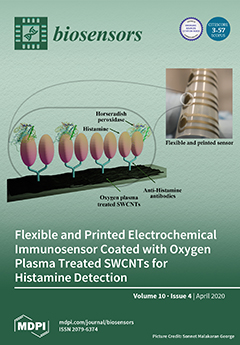Open AccessArticle
Development of Novel Magneto-Biosensor for Sulfapyridine Detection
by
Talha Jamshaid, Ernandes Taveira Tenório-Neto, Abdoullatif Baraket, Noureddine Lebaz, Abdelhamid Elaissari, Ana Sanchís, J.-Pablo Salvador, M.-Pilar Marco, Joan Bausells, Abdelhamid Errachid and Nadia Zine
Cited by 6 | Viewed by 4979
Abstract
In this work, we report the development of a highly sensitive biosensor for sulfapyridine detection based on an integrated bio micro-electromechanical system (Bio-MEMS) containing four gold working electrodes (WEs), a platinum counter electrode (CE), and a reference electrode (RE). Firstly, the cleaned WEs
[...] Read more.
In this work, we report the development of a highly sensitive biosensor for sulfapyridine detection based on an integrated bio micro-electromechanical system (Bio-MEMS) containing four gold working electrodes (WEs), a platinum counter electrode (CE), and a reference electrode (RE). Firstly, the cleaned WEs were modified with 4-aminophenylacetic acid (CMA). Then, (5-[4-(amino)phenylsulfonamide]-5-oxopentanoic acid (SA2BSA) was immobilized onto the transducers surface by carbodiimide chemistry. The analyte was quantified by competitive detection with SA2BSA immobilized on the WE toward a mixture of Ab155 antibody (with fixed concentration) and sulfapyridine. In order to obtain a highly sensitive biosensor, Ab155 was immobilized onto magnetic latex nanoparticles surface to create a 3D architecture (Ab-MLNp). Using electrochemical impedance spectroscopy (EIS), we investigated the influence of the Ab-MLNp on the sensitivity of our approach. The optimized system was analyzed, as competitive assay, with different concentrations of sulfapyridine (40 µM, 4 µM, and 2 nM) and with phosphate buffer solution. From data fitting calculations and graphs, it was observed that the EIS showed more linearity when Ab-MLNp was used. This result indicates that the magnetic latex nanoparticles increased the sensitivity of the biosensor.
Full article
►▼
Show Figures






